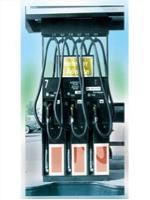Think about Earth's geography for a moment: a fast-running stream cascading over a towering cliff, a rolling hill cresting to reveal a speeding river below, or waves bashing against an island outcrop spraying rocks baking in the sun. Each instance is different but has the commonality of numerous moving parts working to produce an outcome. This observation extends beyond nature and can be found in man-made systems. One such instance is of a fuel island and its individual components working together to safely transfer fuel from underground storage tanks to a portable container. But what kinds of accessories are found at the fuel island and how do they contribute to the end result?
First, a macroscopic view is needed to understand a fuel island and its overall role. The island is a gateway between an underground storage tank supplying product and the nozzle delivering it. As part of the island's role, it must defend piping connections, dispensing hardware and electronic equipment against collisions and instances of high impact. The base of the island is generally composed of steel and concrete, which allows it to absorb energy from objects striking the island. By reducing the overall energy acting on vital components, the likelihood of pipes maintaining their connections increases as well as minimizes the possibility of incurring substantial damage to electronic systems and dispensing hardware positioned at the island.
The general purpose of a fuel island has now been identified, but what accessories are typically found at a fuel island and what are their roles?
Hose retractors are installed at the top of the island structure and typically have a spring-loaded reel and stretch-resistant cable that act to keep excess hose off the ground. By reducing the amount of hose contacting the ground, the chance of customers stumbling or cars driving over it when entering and exiting the fuel island has been lessened. This helps to extend the life of the hose and keeps it from "crowding" the island.
 A flow limiter is installed between the dispenser and the breakaway. This device is used to restrict the flow of gasoline during the fueling process to meet the 10 gallons per minute (GPM) maximum flow rate as mandated by the EPA. Typically, the composition of a flow limiter consists of a zinc/aluminum body and a steel spring.
A flow limiter is installed between the dispenser and the breakaway. This device is used to restrict the flow of gasoline during the fueling process to meet the 10 gallons per minute (GPM) maximum flow rate as mandated by the EPA. Typically, the composition of a flow limiter consists of a zinc/aluminum body and a steel spring.
Positioned at the end of the hose is the fueling nozzle. Customization of color and shape is often offered to meet fuel station operator demands. Fuel stations in the United States generally offer automatic nozzles. This type of nozzle opens when the pumping system becomes pressurized and shuts off when the fueling is completed. Removing the pressure from the nozzle when not in use adds a level of safety by reducing the possibility of accidental spills – protecting the consumer and the environment. With less possibility of spillage, product is preserved, which adds to the bottom line of the operator.
For users of a fueling dispenser, the focus is on the outcome of simply filling a container with fuel. However, there are several smaller working parts that perform a simple, but essential, function that leads to that conclusion. Without these pieces each contributing, the fueling process would not be possible.
To learn more about OPW, contact your local OPW Sales Representative or OPW Distributor.